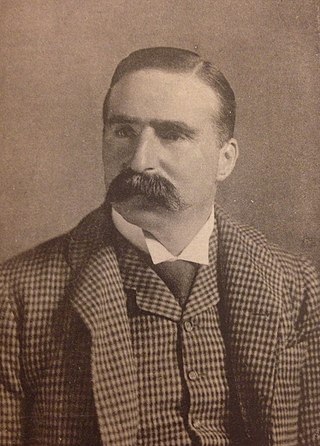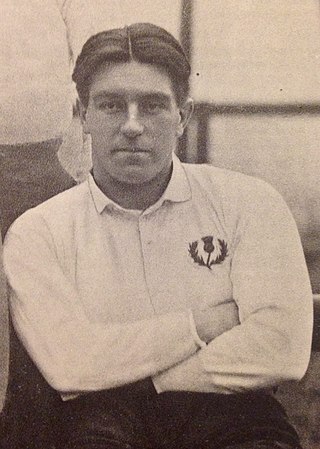Related Research Articles

Francis Walter Stafford McLaren was a British Member of Parliament killed in the First World War in a flying accident.
Walter Riddell Sutherland, also known as Wattie Suddie, was a Scotland international rugby union player.

Cecil Halliday Abercrombie was a Scottish international rugby union player, first-class cricketer, and an officer in the Royal Navy. Abercrombie passed out from the Britannia Royal Naval College into the Royal Navy in 1902, and shortly thereafter he served abord HMS Hyacinth in the British campaign in Somaliland, being part of the force that captured "Mullah" Hassan's stronghold in 1904. He would later serve aboard HMS Defence at the Battle of Jutland on 31 May 1916, during which he was killed in action.

Colonel Richard Davies Garnons Williams was a British Army officer and Welsh rugby union player who represented Wales, Brecon and Newport. He played in the first Wales international rugby union match in 1881.
Henry Arnold Lawrence was a rugby union forward who played club rugby for Richmond F.C. and international rugby for England. He was the third captain of the England rugby team.
Captain Sydney Philip Smith, was a British First World War flying ace, who was credited with five aerial victories, before being shot down and killed, the 76th victory of Manfred von Richthofen.
David Dickie Howie was a rugby union player, who represented Scotland and Kirkcaldy RFC. He enlisted as a trooper in the local yeomanry in September 1914, at the start of the First World War. After undergoing training in England, he was commissioned second lieutenant in the Royal Field Artillery in April 1915 and despatched to Gallipoli in August. During the evacuation of Anzac Bay, he contracted pneumonia, and died in Cairo, Egypt, after shooting himself with a revolver while in a state of delirium. He is buried at the Cairo War Memorial Cemetery.

Lieutenant-Commander John Skinner Wilson was a Trinidad-born rugby player, who represented Scotland, United Services RFC and London Scottish FC. He enrolled in the Royal Navy in 1898. He was killed in World War I in the Battle of Jutland, serving as Lieutenant-Commander aboard HMS Indefatigable. He is remembered on panel 10 at the Plymouth Naval Memorial.
Patrick Charles Bentley Blair was a Scottish rugby union player.

Walter Michael "Mike" Dickson was a rugby union player, who represented Scotland, Blackheath and Oxford. He was killed in World War I.
Maj. Roland Elphinstone Gordon was a Scottish rugby union player and British Army officer who was killed in World War I.
Lt. James Young Milne Henderson was a Scottish rugby union player and British Army officer who was killed in World War I.
Lt.-Col. George Alexander Walker Lamond was a Scotland international rugby union player.
Captain Lewis Robertson was a Scottish rugby union player. He played for London Scottish FC and was capped nine times for Scotland between 1908 and 1913. He also played for the Army from 1904 to 1914, and several other clubs.
Lt. Stephanus Sebastian Leonard Steyn was a Scottish-South African rugby union player and British Army officer who was killed in World War I.
Lt. Albert Luvian Wade was a Scottish rugby union player. He was killed in World War I.

William "Willie" Middleton Wallace was a rugby union player. He played fullback for Cambridge University RFC and was capped for Scotland in 1913–14.

The Arras Flying Services Memorial Commonwealth War Graves Commission war memorial in the Faubourg d'Amiens Cemetery, Arras, France. The memorial commemorates nearly 1,000 airmen from forces of the Commonwealth who were killed on the Western Front during World War I and who have no known grave. The memorial was designed by Edwin Lutyens, sculpted by William Reid Dick and unveiled by Hugh Trenchard, 1st Viscount Trenchard, Marshal of the Royal Air Force on 31 July 1932.

Arthur "Mud" James Dingle was a rugby union centre and wing, who won three caps for England, and played for County Durham, Hartlepool Rovers and Oxford University.
References
- 1 2 Bath, Richard (ed.) The Scotland Rugby Miscellany, p. 209. (Vision Sports Publishing Ltd, 2007 ISBN 1-905326-24-6)
- 1 2 3 4 5 McCrery, Nigel (2014). Into Touch: Rugby Internationals Killed in the Great War. Pen and Sword. pp. 192–193. ISBN 9781781590874.
- ↑ 1901 England Census
- ↑ "John George Will (1892–1917)". Downing College Cambridge. Archived (PDF) from the original on 19 March 2020.
- ↑ "Casualty Details: Will, John George". Commonwealth War Graves Commission . Retrieved 23 June 2018.
- ↑ "Lt John George Will RFC 29 Sqn". The Great War (1914–1918) Forum. 25 June 2011. Archived from the original on 8 September 2024.